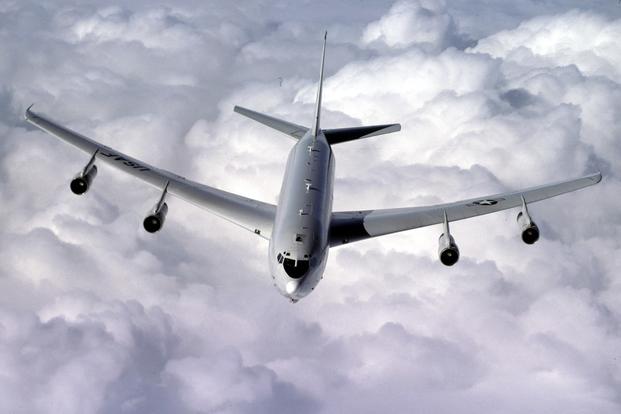The Air Force will not move forward with an E-8C Joint Surveillance Target Attack Radar System replacement aircraft, officials confirmed.
The service on Monday announced that the current JSTARS fleet -- capable of developing, detecting, locating and tracking moving targets on the ground -- will fly into the mid-2020s, but as officials carve out future battle management plans, a new JSTARS aircraft won't be necessary, officials said during the Air Force's fiscal 2019 budget rollout briefing.
"Instead of recapitalizing JSTARS, a platform which is not viable in contested environments prioritized in the National Defense Strategy, this budget reallocates that funding to achieve an advanced battle management system for the future through a new incremental approach," said Air Force Deputy Assistant Secretary for Budget Maj. Gen. John M. Pletcher.
The new effort will capitalize on new and emerging sensor technologies from air, space, sea and land systems and will take the information in a fused-data direction, Pletcher said. The move was first reported by Defense News over the weekend.
Related content:
- JSTARS Replacement Decision Due by End of October
- Lawmakers: Air Force May Scrap E-8 JSTARS Upgrade
- To Make Way for Future Bomber, AF Plans to Retire B-1, B-2 in 2030s
For the first phase, the Air Force is exploring expanding its sensor suite by adding the technologies to platforms such as the MQ-9 Reaper. Depending on how influential the data is, the Air Force could either expand the practice to other fleets, or it may look to another aircraft altogether, Pletcher said.
"It may or may not be a platform," he told reporters during the briefing at the Pentagon. "It's really about taking all the sensors that exist across the domain -- fifth generation aircraft today, unmanned aircraft, space, ground sensors, pulling all that together, which includes sensors that aren't necessarily developed today."
If its a new plane, "it's got to be survivable," Pletcher said. "The point of the Joint Stars discussion, if we recap the current JSTARS, we will have an aircraft that still can't do anymore than it can today … probably [even] less because it will be in a more competitive, contested environment" in the future, he said.
Fusing more systems instead will "enable faster and smarter decisions that will give us the winning edge," Pletcher said.
In December 2016, the Air Force launched a $6.9 billion Request for Proposal for the engineering, manufacturing and development phase of the upgraded aircraft. It had planned to buy 17 new aircraft.
But months later, two lawmakers discovered the service may forgo the JSTARS replacement plan and seek out other aircraft alternatives for the mission.
Georgia Sens. Johnny Isakson and David A. Perdue in August said they were "alarmed" to find out in August that the Air Force may pursue "alternative intelligence, surveillance and reconnaissance platforms" instead of procuring a JSTARS replacement.
Responding to the criticism, Air Force Secretary Heather Wilson said the service would decide whether it would pursue the recap program in October. That date was then pushed back to coincide with the latest budget request.
"JSTARS is about battlefield command and control," Wilson said during a speech in early October.
But there has been a capability gap, she said.
"They're very important to people on the ground to get air support where they need it -- but they're only meeting 5 percent of the [combatant commander] requirement. They have to go back and refuel; there are only a limited number of airframes," she said.
Over the Islamic State battlefield in Iraq and Syria, for example, there are a variety of space assets, fighters, "unmanned aircraft, seaborne radars, ground-based radars and we have the ability to integrate information we didn't have in 1991," Wilson said, referencing the Gulf War.
She added, "Can we pull all that information to give a better picture of command and control, and be putting that on the ground instead of in the back of an airplane?"
The airborne command and control plane, a modified Boeing 707-300 series commercial airframe that can fly as high as 42,000 feet, is "extensively remanufactured and modified with the radar, communications, operations and control subsystems," including a prominent 27-foot bathtub-like radome under the fuselage.
The radome "houses the 24-foot long, side-looking phased array antenna," according to the Air Force.
In an op-ed titled, "Rethinking Radar Plane Recap: Will The Air Force Let Down The Army Again?," Forbes columnist Loren Thompson last year wrote divesting JSTARS would leave the Army -- which relies on the plane's real-time reconnaissance -- high and dry and directly in harm's way on the battlefield.
The Air Force "wants to conduct an 'analysis of alternatives' to determine whether there are better ways to do the mission," said Thompson, who writes about on the strategic, economic and business implications of defense spending for the publication.
Thompson went on to say, "That might sound reasonable if the service hadn't already conducted five such analyses that led to the current replacement program. A sixth review of options would come to the same conclusion, which means what's really going on is the Air Force is trying to jettison the capability entirely.
"Whatever highfalutin' rationale the Air Force may advance for this unfolding debacle, the bottom line is that it just doesn't value Army needs as highly as its own operational priorities," he said.
Currently, 16 E-8 aircraft are headquartered at Robins Air Force Base, Georgia.
-- Oriana Pawlyk can be reached at oriana.pawlyk@military.com. Follow her on Twitter at @Oriana0214.










